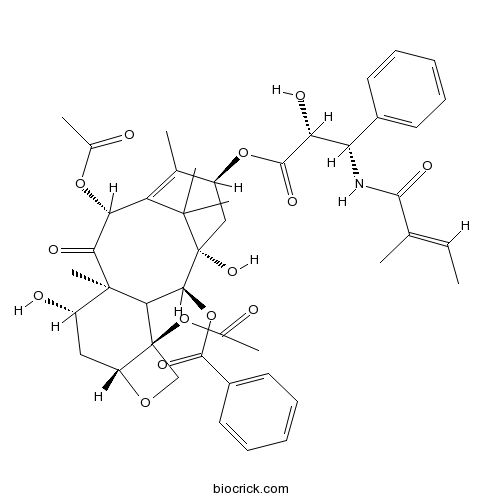Taxus wallichiana
Taxus wallichiana
1. The products in our compound library are selected from thousands of unique natural products; 2. It has the characteristics of diverse structure, diverse sources and wide coverage of activities; 3. Provide information on the activity of products from major journals, patents and research reports around the world, providing theoretical direction and research basis for further research and screening; 4. Free combination according to the type, source, target and disease of natural product; 5. The compound powder is placed in a covered tube and then discharged into a 10 x 10 cryostat; 6. Transport in ice pack or dry ice pack. Please store it at -20 °C as soon as possible after receiving the product, and use it as soon as possible after opening.
Natural products/compounds from Taxus wallichiana
- Cat.No. Product Name CAS Number COA
-
BCN5251
10-Deacetylbaccatin III32981-86-5
Instructions

-
BCN5343
Cephalomannine71610-00-9
Instructions

An endophytic fungus efficiently producing paclitaxel isolated from Taxus wallichiana var. mairei.[Pubmed: 28682896]
Paclitaxel is a medicinal ingredient with high anticancer activity and widely used in hospitals and clinics. In this study, we isolate endophytic fungi efficiently producing paclitaxel from yew for the purpose of paclitaxel manufacture.The bark of Taxus wallichiana var. mairei was surface sterilized and then inoculated in potato dextrose agar culture medium to isolate endophytic fungi. The paclitaxel in the fungal culture was extracted with mixture of chloroform and the same amount of methanol. The content of paclitaxel in the extract was determined and identified with LC-MS. The endophytic fungus efficiently producing paclitaxel was species identified with ITS rDNA and 26S D1/D2 rDNA sequencing.There were 528 endophytic fungal strains were isolated from the bark of T wallichiana var. mairei in total. There was only a strain efficiently producing paclitaxel in these endophytic fungi. The unique strain was identified as Phoma medicaginis. The paclitaxel contents in whole potato dextrose broth (PDB) culture, spent culture medium from this strain and that in dry mycelium is 1.215 mg/L, 0.936 mg/L, and 20 mg/kg, respectively.An endophytic fungus efficiently producing paclitaxel was isolated from T wallichiana var. mairei. This isolated endophytic fungus can be used as a producing strain for paclitaxel manufacture.
Lignans from the Roots of Taxus wallichiana and Their α-Glucosidase Inhibitory Activities.[Pubmed: 28581744]
None
Taxanes from Taxus wallichiana var. mairei cultivated in the southern area of the Yangtze River in China.[Pubmed: 28322597]
None
α-Glucosidase Inhibitory and Cytotoxic Taxane Diterpenoids from the Stem Bark of Taxus wallichiana.[Pubmed: 28240909]
None
Separation and purification of two taxanes and one xylosyl-containing taxane from Taxus wallichiana Zucc.: A comparison between high-speed countercurrent chromatography and reversed-phase flash chromatography.[Pubmed: 28106330]
10-Deacetylbaccatin III, an important semisynthetic precursor of paclitaxel and docetaxel, can be extracted from Taxus wallichiana Zucc. A process for the isolation and purification of 10-deacetylbaccatin III (1), baccatin III (2), and 7β-xylosyl-10-deacetyltaxol (3) from the leaves and branches of Taxus wallichiana Zucc. via macroporous resin column chromatography combined with high-speed countercurrent chromatography or reversed-phase flash chromatography was developed in this study. After fractionation by macroporous resin column chromatography, 80% methanol fraction was selected based on high-performance liquid chromatography and liquid chromatography with mass spectrometry qualitative analysis. A solvent system composed of n-hexane, ethyl acetate, methanol, and water (1.6:2.5:1.6:2.5, v/v/v/v) was used for the high-speed countercurrent chromatography separation at a flow rate of 2.5 mL/min. The reversed-phase flash chromatography separation was performed using methanol/water as the mobile phase at a flow rate of 3 mL/min. The high-speed countercurrent chromatography separation produced compounds 1 (10.2 mg, 94.4%), 2 (2.1 mg, 98.0%), and 3 (4.6 mg, 98.8%) from 100 mg of sample within 110 min, while the reversed-phase flash chromatography separation purified compounds 1 (9.8 mg, 95.6%) and 3 (4.9 mg, 97.9%) from 100 mg of sample within 120 min.
Seasonal Dynamics of Metabolites in Needles of Taxus wallichiana var. mairei.[Pubmed: 27775631]
None
Novel taxane derivatives from Taxus wallichiana with high anticancer potency on tumor cells.[Pubmed: 27153813]
Four novel taxane derivatives, N-debenzoyl-N-methyl-N-heptanoyl-taxol (1), N-debenzoyl-N-me-thyl-N-octanoyl-taxol (2), N-debenzoyl-N-methyl-N-(4-methylhexanoyl)-taxol (3), and N-debenzoyl-N-methyl-N-[(4Z)-1-oxo-4-tenenoyl]-taxol (4), were isolated from the ethanol extract of the whole plant of Taxus wallichiana.var.mairer. These structures were identified on the basis of extensive spectroscopic analysis, and their antitumor activity was evaluated against MCF-7, A549, and 3-AO cancer cell lines by the MTT method. Compound 3, the most promising one, exhibited encouraging effect with IC50 of 77 nm in MCF-7 cells, which was almost matching that of positive control Taxol. In further mechanism study, the tubulin polymerization assay demonstrated that four compounds caused shifts from the soluble tubulin (depolymerized tubulin) to the particulate tubulin fraction (polymerized) which was similar to Taxol. These results revealed novel natural products with paclitaxel-likemicrotu-bule-stabilizing activity owned their major importance in the clinical treatment of cancer.
ISOLATION AND IDENTIFICATION OF AN ENDOPHYTIC FUNGUS PRODUCING PACLITAXEL FROM TAXUS WALLICHIANA VAR MAIREI.[Pubmed: 26667755]
El objetivo de este estudio fue aislar hongos endofíticos productores de paclitaxel a partir de tejo con el propósito de fabricar paclitaxel. Se utilizó la superficie de la corteza esterilizada de Taxus wallichiana var. mairei como material de origen y dextrosa de patata en medio de cultivo de agar para el aislamiento de hongos endófitos. Los cultivos de hongos se extrajeron con una mezcla de cloroformo / metanol (1:1, v/v) y el paclitaxel en los extractos se determinó y autentificó con LC-MS. Un hongo endófito que produjo paclitaxel fue identificado por su ADNr 26S y secuenciación D1/D2 ADNr. Los resultados mostraron que un total de 435 cepas de hongos endófitos se aislaron y purificarón a partir de T. wallichiana var. mairei. Solo una de estas cepas produce paclitaxel y pertenece a Fusarium. La productividad del cultivo de paclitaxel procedente de esta cepa es 0,0153 mg/L y 0,0119 mg/L, respectivamente. El contenido de paclitaxel en micelio seco es 0,27 mg/kg. Este aislado de hongos endófitos produjo paclitaxel a un nivel considerable y muestra potencial como cepa para la fabricación de paclitaxel después de llevar a cabo una mejora de las cepas.


